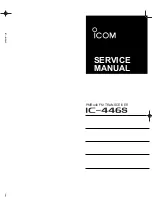
If all parameters are correctly set, start radio operation by following
these steps:
1. Apply DC power to the transceiver.
2. Observe the LED status panel for the proper indications (
Table 7
).
3. If not done earlier, refine the antenna heading of the station to maxi-
mize the received signal strength (RSSI) from the master station.
Use the
RSSI
command from an HHT or PCconnected to the radio
’
s
DIAG
connector. See
Section 4.0, TRANSCEIVER PROGRAMMING
on
Page 15
. This can also be done with a DC voltmeter as described in
Section 3.2, RSSI Measurement
(
Page 14
).
3.1 LED Indicators
Table 7
describes the function of each status LED.
3.2 RSSI Measurement
As an alternative to using an HHT, the radio
’
s received signal strength
(RSSI) can be read with a DC voltmeter connected to Pin 21 of the
DATA
INTERFACE
connector.
Figure 8
shows the relationship between
received signal level and the DC voltage on Pin 21 of the
DATA INTER-
FACE
connector. (Note: Readings are not accurate for incoming signal
strengths above
–
50 dBm.)
PWR
DCD
TXD
RXD
Table 7. LED Status Indicators
LED Name
Description
PWR
Continuous
Power is applied to the radio, no problems detected.
Rapid flash (five times-per-second)
Fault indication.
Flashing once every 5 seconds
Radio is in Sleep mode.
DCD
Flashing
Indicates the radio is receiving intermittent data frames.
Continuous
Radio is receiving a data signal from a continuously
keyed radio.
TXD
An EIA-232 mark signal is being received at the DATA INTERFACE
connector.
RXD
An EIA-232 mark signal is being sent out from the DATA INTERFACE
connector.
14 05-3305A01, Rev. E
Summary of Contents for 1710 Series
Page 55: ...05 3305A01 Rev E 47 NOTES...
Page 56: ...48 05 3305A01 Rev E...
















































